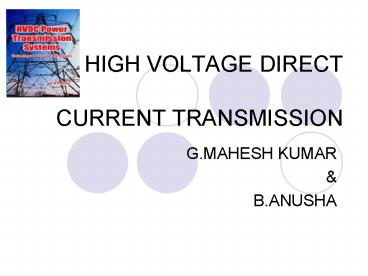HIGH VOLTAGE DIRECT CURRENT TRANSMISSION - PowerPoint PPT Presentation
1 / 22
Title:
HIGH VOLTAGE DIRECT CURRENT TRANSMISSION
Description:
Modern trends in D.C. Transmission Power semiconductors and valves. ... ANUSHA BURA MAHESH KUMAR.G Generation system Transmission system Distribution system WHY HVDC? – PowerPoint PPT presentation
Number of Views:9649
Avg rating:5.0/5.0
Title: HIGH VOLTAGE DIRECT CURRENT TRANSMISSION
1
HIGH VOLTAGE DIRECT
CURRENT TRANSMISSION
- G.MAHESH KUMAR
- B.ANUSHA
2
THE ENTIRE POWER SYSTEM IS DIVIDED IN TOTHREE
MAJOR PARTS
- Generation system
- Transmission system
- Distribution system
3
DISADVANTAGES OF A.C. TRANSMISSION
- In order to provide adequate insulation and to
avoid corona loss spacing between line conductors
is to be kept more in over head transmission
lines. - amount of conductor material required is more
over D.C. two wire system - In long transmission lines capacitance effect
comes into picture .due to capacitance charging
current flows in the line even though the line is
open circuited and produces continuous power loss.
4
- Construction of A.C. transmission lines is not
easy over D.C. lines. - Alternators are to be synchronized before putting
them into parallel. - The variations in the speeds of alternators are
to be controlled with in very low limits to keep
constancy of frequency.
5
ADVANTAGES OF D.C. TRANSMISSION
- It requires only two conductors for transmission
- No inductance, capacitance and phase
displacement. - There is no skin effect and hence full
cross-section of the conductor is utilized. - Less insulation is required.
6
- Underground cables can be used because of less
potential stress and negligible dielectric loss. - For a given load and sending end voltage, voltage
regulation is better for D.C. transmission line. - No stabilizer is required.
7
- WHY HVDC?
- WHAT IS HVDC TRANSMISSION?
- HOW HVDC TRANSMISSION IS DONE?
8
WHY HVDC?
- Energy demand doubles for every 10-12 years.
- Interconnection of technical and economic
advantages
9
HVDC solutions have become more desirable for the
following reasons
- Environmental advantages
- Economical (cheapest solution)
- Asynchronous interconnections
- Power flow control
- Added benefits to the transmission (stability,
power quality etc.)
10
HOW HVDC IS DONE???
- The following steps are involved
- stepping up the generated A.C.
- Converting the A.C. to D.C.
- Transmission through D.C.
- Converting the D.C. to A.C. at the load side
- The main components of HVDC transmission are the
converter stations
11
The main components of a converter station are
- Thyristor valves
- VSC valves.
- Transformers
- AC Filters and Capacitor Banks
- DC filters
12
The HVDC Converter station
13
(No Transcript)
14
Cost Structure of HVDC Transmission
.
15
Advantages of HVDC Systems
- The need for ROW is much smaller for HVDC than
for HVAC for the same transmitted power. - The environmental impact is smaller with HVDC.
- Direction of power flow can be changed very
quickly. - No limits in transmitted distance.
- HVDC can carry more power for a given size of
conductor. - Very fast control of power flow.
16
Limitations of HVDC
- Terminal equipment like valves have little
overload capacity. - Harmonics are produced both on A.C. and D.C.
sides. - These harmonics cause interference with audio
frequency signals. - lack of HVDC circuit breakers hampers
multi-terminal or network operation - Filters are required at both ends
17
WHEN HVDC IS PREFERED?
18
Modern trends in D.C. Transmission
- Power semiconductors and valves.
- Converter control.
- D.C. breakers.
- Conversion of existing A.C. lines.
- Operation with weak A.C. systems.
19
CONCLUSION
- HVDC systems remain the best economical and
environmentally friendly option for the above
conventional applications. - It is quite conceivable that with changed
circumstances in the electricity industry, the
technological developments, and environmental
considerations, HVDC would be the preferred
alternative in many more transmission projects.
20
(No Transcript)
21
(No Transcript)
22
- Thank you !!
- ?
-
presented by -
-
ANUSHA BURA -
MAHESH KUMAR.G































